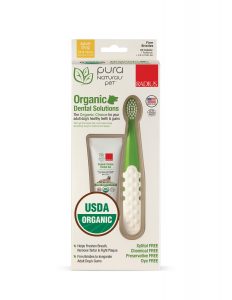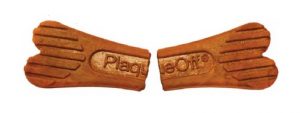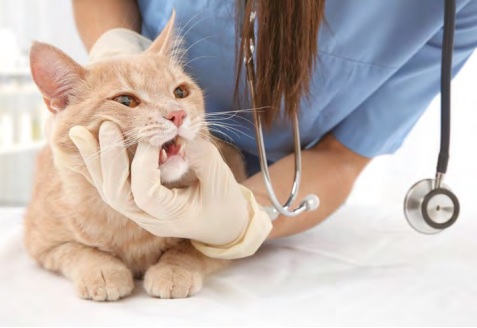Pet Dental: It Doesn’t Have to Stink
Colleen Murphy //February 14, 2018//
Brush twice a day. Go to the dentist every six months. Floss daily. These are rules of thumb many Americans were taught growing up and stick to throughout adulthood. For the most part, Americans take very good care of their oral health, as a healthy mouth is seen as an important factor of presenting oneself to the world. Oral care is a normal part of our daily routine. Oftentimes, however, the effort humans put into their own oral care does not translate to their care routine for their pets. And the stats reflect this.
According to Banfield Pet Hospital’s “State of Pet Health Report 2016,” dental disease—which encompasses inflammation, tartar, gingivitis and periodontal issues—continues to be the most common disease in dogs and cats, affecting 68 percent of cats and 76 percent of dogs. Dental disease can lead to severe pain, tooth loss and infection and has been linked to an increased risk of heart disease, Banfield reports.
While the number of dental disease diagnoses has steadily increased over the past decade, so has the number of owners becoming aware of the effects not keeping an at-home oral care routine for their pets can have. The awareness level kicks up each February, in particular—National Pet Dental Health Month.
Dr. MJ Redman, DVM, DAVDC, a board certified veterinary dentist with MissionVet Specialty & Emergency in San Antonio, Texas, says she has seen an increase in owners being more concerned with their pets’ oral health over the years as more pet dental health material becomes available to owners.
“And I’m glad [the level of concern] has [increased] because I can certainly think when I was a kid and had pets, we didn’t do anything with the teeth because nobody told us to,” she said. “Now, not only is there better information out there, but also better products geared toward smaller dogs who are especially prone to periodontal disease, and I’m really glad to see that.”
Finding the Right Product
No matter the type of dental product her patients want to use on their pet, Dr. Redman encourages pet owners to go to the Veterinary Oral Health Council (VOHC) website. It lists products that have undergone extensive research and testing and that have successfully backed up their claims.
“I tell people all the time if a product isn’t on that list, it may still be effective, but we know the ones on the list are effective,” she said. “And they include diets, chews, toothpaste, drinking water additives, oral rinses.”
Dr. Redman brushes her dog’s teeth once a day and, in addition, gives them different dental chews. She said she uses a lot of Virbac products because of the company’s longevity as well as OraVet by Merial and Greenies (which she said cats also love).
“It’s just different for each pet,” Dr. Redman said. “Some might have dietary restrictions where they can’t have certain diets or chews, but maybe they can have their teeth brushed or they can use the drinking water additive, so you have to tailor it to the specific pet and owner.”
‘Brusha Brusha Brusha’
One dental product for dogs that is being launched this month is Organic Dental Solutions, a toothbrush and toothpaste gel combo pack from the partnership of Pura Naturals Pet and RADIUS. The product was made in response to demands Pura Naturals Pet received from retailers for an oral health produ ct, Pura Naturals Pet President and Chief Merchandising Officer Beth Sommers said.
ct, Pura Naturals Pet President and Chief Merchandising Officer Beth Sommers said.
Rather than create its own toothbrush, Pura Naturals Pet wanted to partner with an industry innovator that specialized in dental—and who shared the same eco-friendly, natural, made-in-the-USA ideals.
“By combining RADIUS’s renowned premium personal care products with Pura Naturals Pet’s expertise on award-winning organic pet health and wellness, the result is a naturally healthier choice for canine dental and wellness,” Sommers said. “We wanted to create a healthier brush and toothpaste gel, as you need both to effectively work well to prevent dental disease.”
First, the brush. According to RADIUS CEO and President Saskia Foley, her company “has been dying to dive into the pet market for quite some time.”
“We believe that pets deserve the same level of quality as their humans, so we wanted to create a kit that is not only safe for pets, but also makes brushing enjoyable for both pet and owner,” Foley said. “We know it can be a chore to brush a dog’s teeth, and so with the Dental Solutions Toothbrush non-slip grip, ambidextrous handle and smooth oval head, it really helps to get the job done without much effort.”
According to Sommers, there is a different brush available for puppies, adults and senior dogs “because all have different hygiene needs, and their toothbrush shouldn’t be the same.”
Second, the gel. Sommers said the team conducted comprehensive research, market insights and discussions with veterinarians in order to include ingredients—such as coconut oil, sweet potato, olive leaf extract and cinnamon powder—that would provide the most health benefits for dogs.
Back when Dr. Redman was in general practice, she said she saw a big diff erence between pets whose owners had an at-home dental routine and those that did not. And the pets that had the very best teeth were those whose owners used some type of electric toothbrush on them, she said.
One of the reasons Dr. Redman suggests owners brush their pets’ teeth is because “it gets people looking in the mouth and to notice a bump or an area that’s bleeding long before it gets to be a big problem.” It is a top form of preventative care.
However, while brushing is recognized as the best way to defend against dental problems, Dr. Redman admits that “realistically, there aren’t as many people who can commit to doing that on a regular basis.”
“Maybe they perceive that it isn’t fun or their animal doesn’t enjoy it whereas giving them something to eat or to chew on is fun,” she said. “So I think probably brushing is the best, but we can’t expect that every single person is going to do that.”
And there are plenty of alternatives to teeth brushing. The different options can even be used in conjunction with brushing for a combined oral care effort.
The Pathway to Pearly Whites
TropiClean Pet Products recognizes that “pets and their people are unique,” and that’s why the company offers multiple solutions to fit their lifestyles, according to James Brandly, TropiClean’s content writer and public relations manager.
“Brushing our pets’ teeth can become a daunting task for some pet parents due to the pet’s behavior with toothbrushes, handling of their mouth and toothpaste associated with the task,” said Brandly, whose Fresh Breath line offers a wide range of non-brushing options. “We wanted to provide products that address the issue with easy to use applications for both pets and their people.”
This year, TropiClean will be introducing its TropiClean Fresh Breath Dental Chews. Th e chewy texture helps fight plaque and tartar with each bite, according to Brandly, and are “expertly crafted with the same natural ingredients as [TropiClean’s] popular Fresh Breath products. Each chew is grain- and gluten-free and made in the USA.”
H&C Animal Health offers three chews for dogs. Its VOHC-approved, vegetable-based C.E.T. VeggieDent Chews for Dogs have a unique “Z” shape so that all areas of the mouth are reached, including in-between teeth.
H&C also has a chew for cats. C.E.T Oral Hygiene Chews for Cats, available in fish and poultry flavors, is a dual enzyme system that helps fight bacteria.
Ark Naturals’ BREATH-LESS Brushless Toothpaste is a chew for dogs and cats with ridges on the outside for abrasive action and the company’s patented toothpaste in the center for plaque, tartar and bacteria control. There is also a chew for senior cats and dogs in Ark Naturals’ Gray Muzzle line.
Other manufacturers of dental chews include Zuke’s, whose easily-digestible Z-Bone Dental Chews are made with a texture that gently cleans dogs’ teeth; Pet Naturals of Vermont’s Breath Bites for Dogs, which are designed to freshen breath; and Isle of Dogs’ nourish dental chews, which have a grooved exterior “made with new, triple-action Pecodent, a proprietary blend of finely ground pecan shell, kelp and turmeric extract that provides natural fiber, helps clean teeth and freshens breath,” the company’s website says.
SwedenCare USA believes in a comprehensive approach to oral care and so offers a line of natural products so dog, cat and even horse owners can do just that, according to the company’s vice president of sales and marketing Scott Reinhardt. The key to the whole program is daily use of PlaqueOff, Reinhardt said.
PlaqueOff is derived from a specific thick strain of sea kelp that comes from the North Atlantic, according to Reinhardt. SwedenCare USA cultivates and packages the kelp, which “has a specific intrinsic value that changes the biochemistry of the mouth, eliminating the opportunity for plaque and tartar to adhere to the teeth.” PlaqueOff is found in all three products: ProDen PlaqueOff Powder; ProDen PlaqueOff Dental Bites; and, newest to the lineup, ProDen PlaqueOff Dental Bones.
The powder is sprinkled over wet or dry food, and with continued daily use, a dog or cat’s existing plaque or tartar will begin to break down after usage, Reinhardt said. The powder can especially be good for owners who feed their cats a wet diet and dogs a raw diet.
“One of the things that the cat folks do more than the dog folks do is they feed the cat wet food, and you get a higher concentration of plaque and tartar developing when you’re feeding wet products. When you’re feeding a kibble product, chewing on the kibble will help abrase and clean some, but people who feed wet food—and on the dog side, people who feed raw diet—they don’t get that chewing action with their daily feeding routine,” he said. “So again, by putting the PlaqueOff on the wet food, the cat doesn’t even know it’s there. They get the ingestion of the PlaqueOff right then and there, and that’s the solution.”
The Dental Bites, which recently earned a VOHC seal of approval and are for dogs and cats, complement the powder’s daily use. Or, if an owner and pet are traveling and are unable to use the powder, they can be the pet’s daily dose of PlaqueOff.
According to Reinhardt, seeing the VOHC stamp on the Dental Bites label will influence a consumer’s purchasing decision because it provides credibility to the package’s claims.
The bone, designed for dogs, has been well-received, selling out at trade shows. It is highly digestible and available in four flavors:  vegan, turkey and cranberry, chicken and pumpkin, and bacon.
vegan, turkey and cranberry, chicken and pumpkin, and bacon.
“We made [the bone] very pliable so teeth would actually sink into the product, and by doing so, it would help abrase the plaque and tartar that already might be on the dog’s teeth,” Reinhardt said. “It’s got grooves on one side and heart-shaped points on the other which help abrase and [get to] crevices.”
Like the other SwedenCare USA products, the bone has a daily dose of PlaqueOff in it. And since they can break in half, there is one size for all dogs, which means retailers can save on shelf space, Reinhardt pointed out.
A chew/toothbrush hybrid, the Brite Bite Brushing Stick by Project Play is a rubber dental chewing brush on which dogs can bite down to scrub their own teeth. It’s especially good for cleaning the hard-to-reach back molars, according to the company’s website. The “rigid bristles grind away plaque and loosen tartar in hard to reach places,” and toothpaste can be put in the brush’s grooves.
Owners can also wipe pets’ mouths clean. earthbath’s Tooth and Gum Wipes clean away plaque, tartar and odor-causing bacteria. TrueBlue Pet Products’ Fast and Fresh Dental Swipes provide friction for plaque removal, as well.
There’s also the options of dental sprays, foam and liquid water additive, all of which chew and dental company Nylabone produces.
Even getting pets the right type of toy is one way to help combat dental problems.
Mammoth Pet Products has more than 125 SKUs in all of its Flossy Chews sub-categories, according to VP of Sales and Marketing Mark Pasco. Flossy Chews are made of fibers that can help keep pets’ teeth clean and strong with each chew, tug or pull. The company recently released its Extra Fresh subcategory.
“We’re using the polycotton woven sheath as an outer core with an inside regular polycotton strand and then, in addition, we’re using real dental floss throughout the woven sheet,” Pasco said. “And what we do with that is take the real dental floss and dip it in mint and beeswax to keep that in check, and it’s actually woven into the material.” 
Of course, for most, Mammoth toys are primarily seen as that—a toy. The fact that the labels call out Flossy Chews’ oral hygiene benefits is just an added selling point, Pasco said. However, Pasco did say that sometimes people search for toys with the keyword “dental,” purposefully looking for toys that can help in the fight against dental disease, in which case Flossy Chews will come up. Pasco also said that Mammoth experiences an increase in sales of Flossy Chews around February because of it being Pet Dental Health Month.
The Fetch ‘n Floss from Pet Qwerks is another toy that promotes dental health. Soft and durable, the BPA-free ring chew is made of synthetic rubber and available in three colors, according to the company’s website.
Petstages has toys to promote oral health for cats, too. According to the company’s website, its Fresh Breath Mint Stick removes soft tartar and freshens breath as the cat chews. Its Catnip Plaque Away Pretzel cleans teeth and massages gums. There is also the Catnip Chew Mice, Dental Health Pair Chews and Kitty Chew Wheel.
Don’t Forget
Dogs and cats aren’t the only pets whose oral needs have to be addressed. Not taking care of small animals’ teeth can lead to health complications, as well. Many small animals, including rabbits, guinea pigs and rats, have teeth that are open-rooted, meaning they are continuously growing. Unlike cats and dogs, small animals don’t necessarily need to have their teeth brushed. Instead, to help ware the teeth, owners need to provide small animals with a natural diet and plenty of items on which to chew. If small animals don’t receive the necessary tools to keep their growing teeth under control, the teeth can overgrow, which can lead to the development of mouth ulcers or even the inability to eat and carry nesting materials.
LIXIT offers Critter Gnaw Dents and Critter Chopsticks to satisfy small animals’ natural chewing behavior. The two are made from natural hardwood grown in the Pacific Northwest, the company’s website says. Wild Harvest has Colored Wood Chews, a Natural Chew Ball and a Chewable Branch to encourage oral health upkeep.
Supreme Petfoods’ Science Selective small animal food line has recipes formulated with zero added sugar. According to the company’s site, added sugars can damage teeth. Its Tiny Friends Farm Russel Rabbit Tasty Nuggets also have no added sugar.
“They’re very good at hiding problems, so sometimes, by the time you notice a dental problem, it can be really severe,” Dr. Redman said.
Similar to small animals, birds need products to help prevent beak overgrowth and can benefit from items such as the Bird Banquet Mineral Block (Mealworm Formula) and Banquet Cuttlebone, both from Zoo Med.
Selling It
As veterinarians and manufacturers put more information out there about the importance of at-home oral care for pets, more owners will look to retailers for dental products. And the education of pet dental health should continue at the store.
Jules Smith, a marketing specialist for H&C, points out educating consumers in a retail setting can be different than in a veterinary office. After all, in a veterinary office, the doctor tells the owner what products the pet needs and might be able to supply them with the product right then and there. To compete with that service, to promote products and to get customers to be proactive about dental health, H&C recommends retailers also know the statistics and clinically proven facts. Further, she suggests retailers “make sure signage is prominent” and they can “explain when and why to use different dental solutions.”
Pura Naturals Pet will help retailers in educating customers about its new Organic Dental Solutions by creating “a whole campaign on ingredients and product benefits and features and back it with shelf talkers, data sheets, education pieces, social media posts and [URLs] retailers can share,” according to Sommers.
If customers are unsure of which type of dental product their pet might take to or wants to use multiple items, suggest they try a kit.
According to Brandly, the TropiClean oral care kits give owners a range of dental products to test.
“Our oral care kits include brushing gel and toothbrushes, and some include our Fresh Breath Drops. These kits combine multiple oral care products for the pet parents to try,” Brandly said. “Once pet parents find a product that they can trust and that their pets love, then they’re more willing to try other great products from that brand.”
H&C Animal Health also offers a combo pack called the C.E.T. Enzymatic Toothpaste and Oral Hygiene Kit, which is available for both cats and dogs.
“[It is] a complete kit with everything a pet parent needs to start an oral hygiene routine with their pet,” Smith said. “Included in the kit is a C.E.T Fingerbrush, C.E.T Dual-ended Toothbrush and Poultry-flavored Enzymatic Toothpaste.”
Stocking such a kit in a store can allow for customers to figure out which product they like best and return to buy more of it.
Dr. Redman said some of the most effective ad campaigns she’s seen are those that compare pet dental health to human issues.
“Most humans are aware of how uncomfortable a problem can be, and to just be aware that their pets can have the exact same problems—they can have abscess teeth, dogs can get cavities like humans do (not as commonly, but they can). And so just being aware that that exists,” she said.
Most importantly, retailers can convince customers that dental care should be part of a pet’s daily routine—just like it is humans’.
“We all expect we’re going to feed them and brush them and walk them and give them water, but also part of that should be checking their teeth,” she said. “And you can certainly get them used to it. Most animals will cooperate, especially if you start them when they’re young.”



















